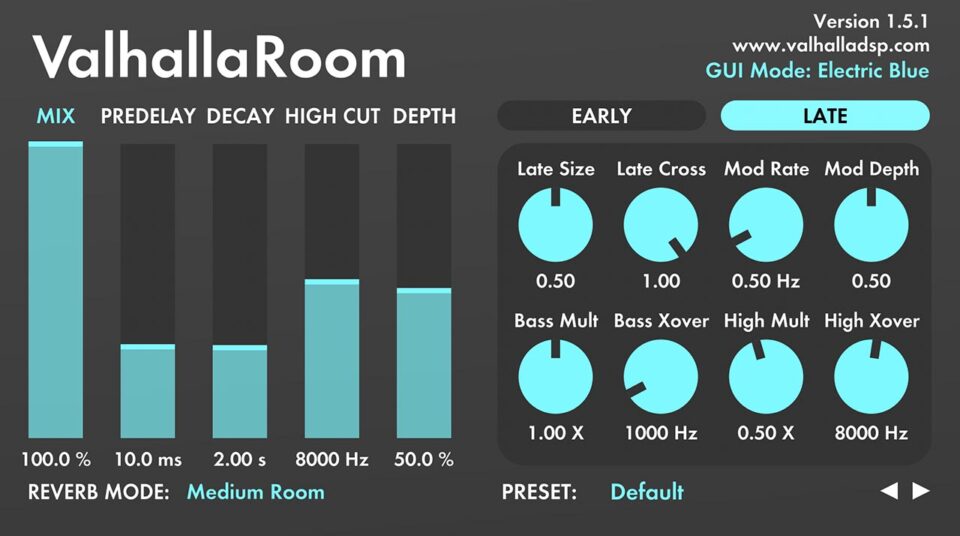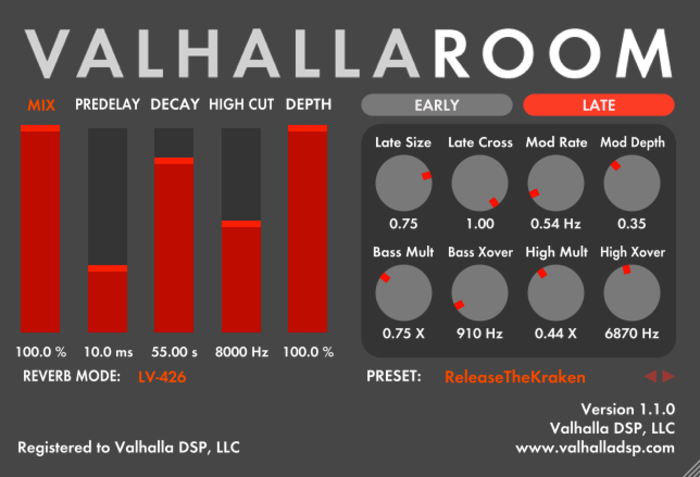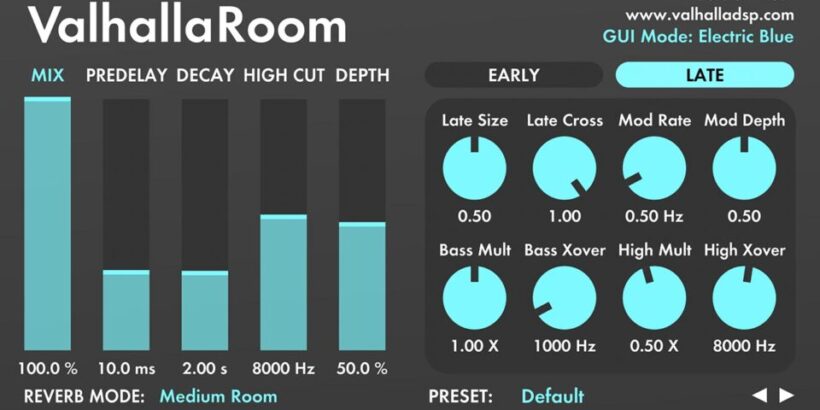Valhalla Room Crack + Product Key

Valhalla Room Crack It features twelve original reverb algorithms (including the latest Dark, Nostromo, Narcissus, Sulaco, and LV-426 reverb modes) and produces a wide range of natural reverb sounds. Sounds range from tight environments and spaces, to traditional reverb and panel sounds, to expansive modulated spaces. The algorithm designs have been influenced by some of the “classic” room simulation boxes as well as more modern theories.ValhallaRoom was designed from a psychoacoustic perspective. Rather than creating a simplified physical model of a simplified physical space,
Room creates early and late acoustic energy that provides the spatial and phase cues needed to create an “idealized” sense of space. Now that ValhallaRoom is out for OSX and Windows, I’d like to post a few blog posts covering reverb features, how to get the sound you want, tips and tricks, and more. To begin, let’s look at the GUI and walk through the different sections of ValhallaRoom: At the top is the title of the plugin “VALHALLAROOM”. This is where my love for typography comes in. Futura Demibold is displayed as prominently as possible. From a design point of view, the title serves to compensate for the large empty space at the bottom of the plugin (the purpose of this empty space is explained below).
You may also like this Valhalla Plate Crack
Valhalla Room Crack Features
- At the bottom left of the title are five vertical sliders.
- These sliders (Mix, Pre-delay, Decay, High Cut, Depth) are the controls that have the most immediate dramatic effect on the sound and are probably the most commonly used.
- The buttons below and to the right of the title are familiar Select if you want to edit the Early Reverb or Late Reverb section Valhalla Room Product Key.
- Red means the specified section is modified, gray means it is not. Below the Early/Late knobs are controls for controlling the Early/Late reverb parameters.
- These settings tend to be “finer” than the larger red sliders, allowing the user to choose from different views depending on their needs. In the area below the sliders is the reverb mode selector.
- This selects one of four reverb algorithms, each with a distinctive sound.
- In the area below the Early/Late controls is the Preset section.
- The currently active preset is displayed as a red title on a charcoal background.
- Click on the red word to bring up the presets menu,
- where you can browse, load and save presets, copy the current state of the plug-in to the clipboard, and paste data from the clipboard into the plug-in (which is a great way to load presets via email or forums)
Valhalla Room Crack System Requirements
- Tooltips are displayed in the black area at the bottom of the plugin window.
- Hover your mouse over a slider, knob, button, etc., and that section will display a tooltip with a brief explanation of how to use that control.
- The lower right corner displays the current version number and all relevant suffixes (b for beta, d for demo, PPC for Mac PowerPC).
- The company name and URL are also displayed in case you forget it.
- The idea behind the GUI was to organize the controls logically so that their size and display state were an accurate representation of their relative importance.
- The GUI is also proudly 2D, with the controls being an abstraction of buttons and sliders rather than a surrogate representation of hardware that doesn’t exist.
- Futura Demibold was chosen as the font because it is specified as the control panel font in the NASA usage guidelines and just looks cool.
- The tooltips section is an attempt to include documentation as a design element, in keeping with minimalism/Swiss school influences Valhalla Room Activation Key.
- With HIGH CUT, the high frequencies of the decay can be tamed. A real room is often much darker than you think, so feel free to lower the setting to 5000 Hz.
- A brighter room can be set between 6 and 9 kHz. The DEPTH command is used to define the relationship between previous and later energy.
- A setting of 50% is a good starting point. The Early Size setting can be used to add a brief amount of early reflection energy to the attack when set to a range of 10-30ms.
- A setting of 50-100ms is useful for getting a slight gated sound or for simulating decay envelope flattening caused by heavy limiting/compression or tape saturation.
- Note that the overall decay time increases with the Early Size setting.

What’s new Valhalla Room Crack
- The Early Send control is crucial for shaping the early attack of short room sounds.
- By setting Early Send to 0.0, the initial attack can vary between flattening and exponentially decaying by adjusting the DEPTH control to fade between the early and late reverbs.
- When Early Send is set closer to 1.0, the Early Size setting will dominate the decay of the early and late reverb, creating a flattening of the initial decay.
- ValhallaSupermassive is 2 years old and to mark the occasion we are releasing the 2.0.0 Supermassive update with two new reverb modes, Aquarius and Pisces.
- Both Aquarius and Pisces are modified feedback delay networks in a topology I call EchoVerb.
- These algorithms have a loud audible echo that directly corresponds to the displayed delay time.
- By modifying WARP, FEEDBACK, and DENSITY, Aquarius and Pisces can be used for standard delays, delays with mixed reverb, reverb with heavy pre-delay, or weird and wild echoes.
- Late Size should be set to 0.5 or less to produce the highest initial echo density. Late bass should be set to 1.0X or less.
- Lower values give more clarity to the decay. In general, leaving the early and late modulation depths at 0.0 produces a more realistic spatial sound.
- However, if you want to emulate the super chorus “space” of the EMT250, you can definitely increase the modulation depth!
- A few sample presets (copy them to your clipboard and select “Paste from Clipboard” from the presets menu to hear the audio), starting with a small realistic piece Valhalla Room Serial Key:
How to install it?
- Aquarius mode is similar to earlier Capricorn mode in that it has 8 delays in the feedback delay network.
- The main change is that Aquarius only has two delays in the output signal: one for the left channel, one for the right channel.
- The left and right output delay lengths are the same regardless of the WARP setting. This causes a very audible echo/delay in the signal, especially in low-DENSITY settings.
- When the DENSITY control is increased, more of the outputs of the other delays in the feedback delay network are sent into the overall feedback path, resulting in a more reverberant sound – or more comb filtering at low WARP settings
- . With WARP set to 0% and modulation depth to 0%, increasing DENSITY introduces strange cancellations into the echo signal that can create interesting polyrhythms and panning.
- Pisces mode is essentially a denser version of Aquarius mode and can be thought of as a modified Gemini mode with only two output delays (one for the left channel, one for the right).
- When the DENSITY control is on, the outputs of the other delays in the feedback delay network are mixed into the global feedback path Valhalla Room License Key.
- Because there is more delay in Pisces mode, the reverb builds density and richness faster than in Aquarius mode.
- I believe these two new reverb modes, Aquarius and Pisces, are the most generally useful modes in Supermassive.
- Weird sounds are certainly possible, but these modes specialize in reverberating echoes – i.e. H Echoes with a bit of reverb mixed in.
- Switch delay time to tempo sync and the new modes are great for adding rhythmic delays to your music, with as much or as little reverb as you want.
- The DENSITY control lets you adjust the time it takes for the echoes to convert to reverb, which is perfect for keeping your sounds defined in your mix!
Conclusion
In my previous article, I discussed the shimmering sound of Eno/Lanois and how it is based on a pitch shifter and digital reverb placed in an overall feedback loop. It’s worth looking at what’s going on at the micro level in this signal chain and how fairly simple signal routing can create such a complex sound. to find the sweet spots to merge the timescale waveform slices. It presumably worked similarly to the H949 anti-interference map, using autocorrelation to find the most similar segments of the waveform and adjusting the delay time of one of the channels for a connection ideal.
It is also possible that autocorrelation triggers a new splice, so the rate between splices was a function of the periodicity of the input signal. Autocorrelation is well suited for determining junction points, provided the input signal has some degree of correlation. For example, a single sustaining guitar note after the initial attack may have a high autocorrelation factor. But what happens when the signal to be shifted has a very low autocorrelation factor? Such a signal is said to be decor-related; that is, the auto-correlation or cross-correlation is said to be strongly reduced compared to the original signal Valhalla Room Vst.
